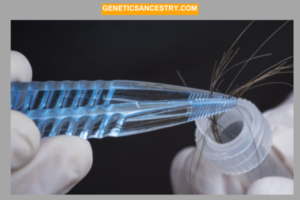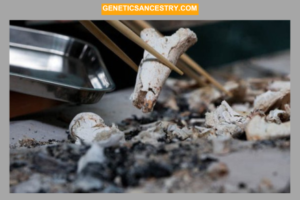Introduction
Trying to get DNA from the ashes of someone who has been cremated is not possible once they have been reduced to ashes. The cremation process generally destroys any DNA that was there in the remains because of the intensity of its heat. Therefore, to answer the question, ‘Can you get DNA from ashes?’ the answer is nearly always no, you cannot. However, there are some companies that will do DNA testing on the remains of a cremated person, they are also very careful to state that the success and reliability rates of such testing are very low because of the poor quality of the sample.

Extracting DNA from Teeth
Can you find ethnicity from ashes DNA? Can you get ancestry DNA from ashes?
Teeth are a good source of DNA and are often used in post-mortem paternity testing. They are usually the most reliable source of DNA followed by bones in cases where the alleged father has been buried. This is especially true when a considerable postmortem interval has elapsed. In terms of DNA, teeth have an added advantage over bones because they remain locked within the mouth. This provides an added layer of protection, protecting the DNA from environmental factors. Environmental factors speed up the decomposition process. Bones are directly exposed to these factors.
The root of the tooth contains more DNA than the crown—an important point to keep in mind. So, can you find ethnicity from ashes DNA? Yes, it is possible because DNA can be extracted from the tooth.
Can you do Forensics on ashes?
In some instances, post-mortem genetic testing may be needed for forensic or legal purposes. The reasons could be to identify the deceased person, provide evidence in investigations of a criminal nature, or resolve familial or paternity issues.
Post Mortem DNA Testing
Can you get DNA from a deceased person? How long after death can you get DNA? In the best-case scenario, all DNA samples should be taken for testing in the shortest period of time to avoid degradation of the DNA sample. This is even more important if the DNA sample contains un-dried tissue because of putrefaction. Putrefaction refers to the destruction of soft tissues and usually takes place a short time after death. This is because of the behavior of micro-organisms on the body which will cause a rapid breakdown of the cells and the cell nucleus. Therefore, un-dried tissue shall decompose faster due to its water content.
Read More At:
- How to Find Old Orphanage Records
- How To Find Burial Plot Deeds
- Decoding Ethnicity: Unraveling Human Ancestry through Bone Analysis
- What is a Great Uncle?
- Top 10 DNA Test Kits For Siblings in 2024?
So, when is it too late for a DNA test? Human decomposition starts just a few minutes after a person has passed away. This happens through a process of self-digestion known as autolysis. Once death occurs, all cell activity stops. The human body has a number of enzymes that start digesting the cell cytoplasm once someone has died. The surrounding temperature and humidity levels play an important role in the autolysis process. Lower levels of humidity and temperature will slow down the rate at which autolysis takes place. Laboratories usually store cell samples in a cooling isotonic solution. This helps to preserve the cell and its DNA. Unfortunately, not even freezing a body can completely stop the decomposition process.
| G-grandparents | RELATIONSHIP | HOW MANY | DNA% |
| 7 | GGGGG-grandparents | 128 | 0.78 |
| 6 | GGGG-grandparents | 64 | 1.56 |
| 5 | GGG-grandparents | 32 | 3.12 |
| 4 | GG-grandparents | 16 | 6.25 |
| 3 | Great-grandparents | 8 | 12.5 |
| 2 | Grandparents | 4 | 25 |
| 1 | Parents | 2 | 50 |
When Peter heard about 23andMe, he decided that it was time to find out more about his ancestry. The families of both his father and mother had been affected by the war and the Holocaust. This meant that there were very few survivors left. The story was the same for many Jews from Hungary. The number of Jews in Hungary before the war was about 6% of the country’s total population. When the war came to an end, the total number of Jews was only about 0.1 of the total population.
For those who lost ancestors in the Holocaust like Peter, it is not easy to piece together their families’ history. Many organizations have been formed over the years, to help both survivors as well as their descendants put together the missing pieces of their past. Though these are important resources, Peter wanted to make connections with 23andMe.
He discovered his ancestry, which included Sephardic and Ashkenazi Jewish roots. He found more than than1000 DNA relative matches, third and fourth cousins. Recently he found second cousins and one first cousin. These connections have helped him discover whole branches of his family tree that he did not know existed. He has been able to connect with many of his closest connections. He has learned that some of his relatives escaped Hungary before and after the war. They immigrated to Israel and the United States. He also discovered that one of his great-grandfathers survived the death camps. Those relatives have told him about a family history he would never have known about.
How to get DNA from a Dead Person?
There is more than one way to get DNA from a deceased person. The first option would be to get a sample of their hair. Hair follicles contain DNA, so even the smallest tuft of hair will give you an adequate sample to work with. The second option would be to make use of their bone marrow. Bone marrow is a rich source of DNA so it can be helpful in getting you the material, even if it is only a small amount available. Lastly, it is also possible to use skin cells. Though they may not be as rich as bone marrow or hair in DNA, skin cells can still provide a usable sample. Generally, any human tissue that has cells that have a nucleus will have DNA that you can use for this purpose.

DNA Testing with Hair Samples
Can you get DNA from a dead person’s hair? Hair samples can also be collected from the deceased. However, they need to be plucked in such a way that the root or hair follicle remains attached. Nuclear DNA can be found in the hair follicle but not the hair shaft. Hair shafts contain very little nuclear DNA because of an incomplete process of cornification. Cornification is the process that converts squamous epithelial cells into the keratinized material that we call hair. In addition, the hair shaft contains mitochondrial DNA, a maternally inherited type of DNA. Mitochondrial DNA can be used for DNA identification but it has one setback. Everyone inherits an exact copy of mitochondrial DNA from their mother. Only women can pass the mitochondrial DNA that they inherited so we can see how this DNA can be used to trace maternal lineage.

Post Mortem Toxicology
Can you test cremated ashes for poison? When investigating a potential case of poisoning or foul play, Toxicology testing can detect measure, and identify any foreign substances in biological samples like hair, vitreous fluid, urine, and blood to provide independent, private, and comprehensive toxicology testing reports. The same can be prepared for ashes or cremains. Cremated remains can be tested for the five most commonly found poisons or toxins. These are arsenic, cadmium, chromium, lead, and mercury.
Israel’s rich history is a tapestry woven with diverse threads. This article aims to explore the genetic landscape of Israel, shedding light on its DNA ethnicity, the multifaceted composition of its population, and the intricate genetic connections that bind individuals of Israeli descent.
Main Ethnic Groups In Israel
Can you Get DNA from Dog Ashes?
Unfortunately, you cannot get DNA from dog ashes. This is because the DNA needs to be in a living state in order to be viable. There is no genetic material in an animal’s ashes that can be viable because there are no living cells.
Can you get DNA from Ashes Ozark?
When investigators arrived at the Return to Nature Funeral Home in the Rocky Mountain town of Penrose, they found dozens of stacked bodies. This is according to a federal affidavit sealed in Colorado but available in Oklahoma. According to the document, there were bodies that had 2019 death dates. Law enforcement is confident that the ashes that were given to each family are probably not those of their loved ones. There is an ongoing process aimed at identifying remains using dental records, fingerprints, medical hardware, and if necessary, DNA. So far, 110 out of 190 sets of remains have been identified and 25 have been returned to their families.
Can you Get DNA from Cremated Ashes?
In order to respond to this question of whether you can get DNA from ashes, it will help to review what the cremation process entails. Typically, it starts with the preparation of the body. This involves getting rid of any foreign items like medical devices and jewelry. The body is then put inside a cremation container and then taken to the cremation chamber. The cremation chamber is also known as a retort. When inside the retort, the body is then exposed to very high temperatures.
These temperatures range from 1400 to 1800 degrees Fahrenheit. This is relayed through the use of flames, jets, or electrical heating elements. This high heat will reduce the body to pieces of bone, known also as ashes or cremated remains. After these ashes have cooled, they are cleaned up to remove any remaining impurities and then crushed until they have a consistent texture. In the end, the cremated remains are put in a container of choice, usually called an urn. This urn would be kept by the family, interred in a memorial site or cemetery, or scattered in a place of choice.
Therefore, because of the intensity of the above-described process, there is no way that you can get DNA from ashes.
How is post-mortem Genetic Testing Performed?
A post-mortem genetic test refers to the process of taking samples such as blood or tissue from a deceased person. For this to happen there is a form that needs to be signed by the next of kin in order to give consent. Once this is done, scientists then extract DNA from the available samples and perform analysis on them. So, can you extract DNA from ashes? The answer would be yes. This is done using different types of “genome sequencing”. The information that is collected is then compared to some other genetic information usually provided by family members. This process can be used to determine genetic differences or similarities. So, Can you do forensics on ashes? It is possible to do forensics on the ashes of a deceased.
Conclusion
In recent years, DNA testing has become increasingly popular. This is due to the need for people to discover about their heritage. Even though DNA tests do provide information that is accurate about a person’s ancestry, they are not always able to determine the relatives of a deceased person. The reason for this is because DNA tests can only identify specific genetic markers. However, not all people have the same genetic markers.
FAQ’s
Can you Identify a Person by their Ashes?
No, it is not possible to identify a person solely by their ashes.
What are the limitations of current forensic techniques in analyzing cremated remains?
Forensic methods struggle to preserve genetic material during the intense heat of cremation, limiting accurate analysis.

